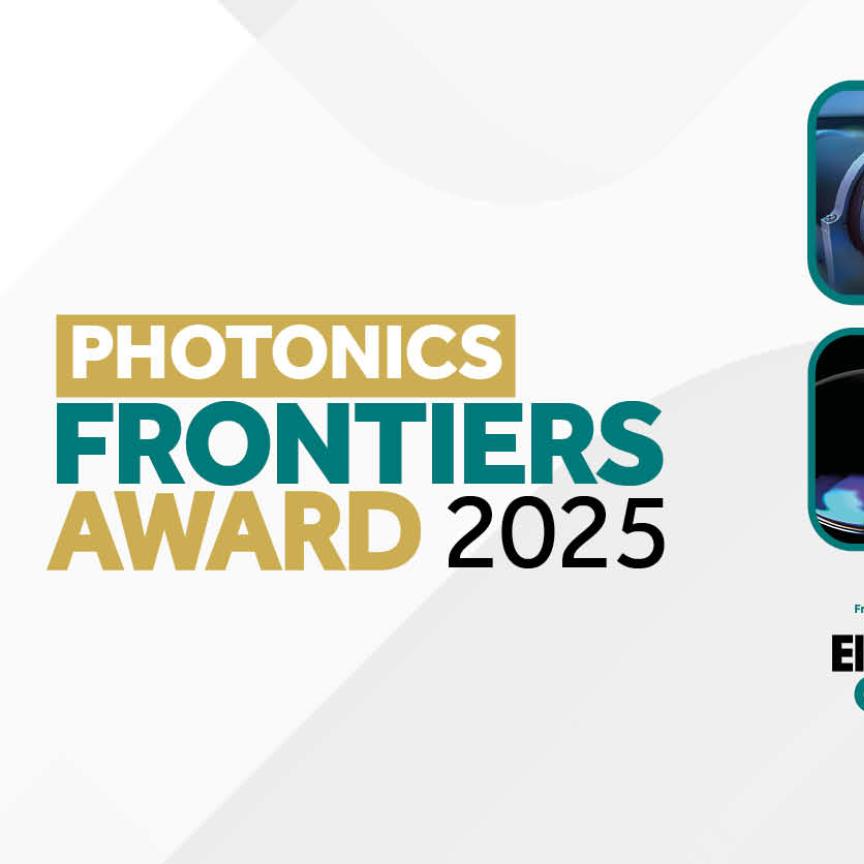Laser welding
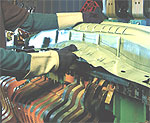
An automotive body part is prepared for laser welding by RobScan. Photo Courtesy of Trumpf.
According to Hans-Josef Haepp, head of production and materials technology at DaimlerChrysler, speaking at Laser 2005, the traditional method of joining the parts of an automotive body usually consists of 60 per cent spot resistance welding, 15 per cent adhesive bonding, with the remaining fraction taken by mechanical joining methods, such as nuts and bolts. One drawback of spot-resistance welding is that it can be used to weld only conductive materials, when both sides of the weld are the same substance (to avoid electrolysis effects). In contrast, two popular materials used in automotive manufacture, steel and plastic, cannot be joined using resistance welding.
Wider trends in the industry have also highlighted drawbacks of resistance spot welding. If manufacturers are to meet consumer demands for greater variety of models they need their production lines to be more flexible, but economic pressures to reduce vehicle production costs require stable manufacturing processes. Manufacturers try to reduce vehicle weight to improve fuel efficiency and improve performance. This had led to the investigation and use of new lighter materials for vehicle coachwork, such as stronger steel and aluminium alloys. These are difficult to join using traditional spot welding.
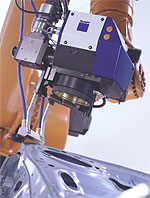
RobScan consists of a pumped disc laser, a light conducting cable, and a controlling scanner, mounted on a robotic arm. Photo Courtesy of Trumpf.
To address these problems, DaimlerChrysler, in partnership with the laser technology division of Trumpf and with the University of Stuttgart, developed 'RobScan', a new robotic laser welding system now being used at Mercedes-Benz. Laser welding improves quality: 'DaimlerChrysler has high standards and is very demanding' said Sven Ederer of Trumpf's laser technology division. RobScan consists of a pumped disc laser, a light conducting cable, and a controlling scanner. The scanner can be programmed to follow a weld seam. Not only is this system 10 times faster than traditional spot welding, but it also gives stronger joints, which leads to better structural rigidity and, perhaps most important, better crash protection. Laser-welded joints absorb more energy than spot welds and do not distort so much in a crash. DaimlerChrysler hopes to expand this technology into the manufacture of engine and transmission assemblies, as well as increasing its use for body construction.
But what of the future of laser body welding in automotive manufacture? Peter Leibinger, executive vice president of Trumpf, expects the automotive industry in Japan and Korea to take the lead in the use of laser welding and laser machine tools in the manufacture of motor cars. Leibinger believes that adoption of laser technology by the US automobile industry will be slower, but the company has had demand from the US for its laser.
Plastic welding
Moulded plastics are used widely in automotive components. Even apparently simple components, such as headlights and tail-lights, can have complex geometrical shapes, and this geometrical complexity may pose a formidable problem when it comes to joining the constituent parts to assemble the lighting unit. To create a good bond, the parts need to be held together tightly along the seam while they are being joined. Otherwise, the joint may come apart later - an undesirable consequence in any case, and a particular issue if the seal is supposed to be watertight.
Leister's Globo welding system provides such an ingenious solution to the problem that it won the Swiss technology award in 2004. A laser beam is focused at a point on the joint by an almost frictionless, freely rotating glass sphere. One joining layer can be heated independently of the other. In headlight production, this means the casing substrate can be heated without distorting the transparent part of the assembly. The glass sphere not only focuses the light, but also applies continuous contact pressure at the focal point on the joining plane. A clamping device is not needed, meaning that both time and money can be saved during the production process. The rolling sphere allows complicated three-dimensional shapes to be welded, reducing the number of stages and separate devices used during the joining process.
Rofin, which specialises in industrial laser material processing, is investigating how plastic laser welding can be used for novel and efficient production techniques, such as building and sealing key fobs, and attaching ancillary components within the vehicle cabin. For example, laser welding means modern essentials, such as hands-free mobile phone microphones, can be fitted almost anywhere, even mounted upon the seatbelt.
Lasers are also used for marking components, such as driver readout instruments that require a day and night design, i.e. they must be visible in daylight as well as when backlit during night-time driving. Instrument panels are injection-moulded in transparent plastic. Once formed, one side is spray-painted first with a white undercoat, then a black topcoat. A high precision laser, controlled by a computer, then removes the black layer in a pre-programmed pattern; leaving white characters against a dark background. These can be easily backlit for night-time operation.
Laser polishing
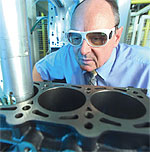
Horst Lindner, responsible for the development of production processes at AUDI AG, checks the laser exposure of an engine. Photo courtesy of Audi.
Lasers are not only being used for welding automotive materials, but are also being used to replace other formerly mechanical processes, such as polishing the cylinder liners in diesel engines.
With increasing European petrol prices, efficient diesel engines are more popular than at any time. Automotive manufacturers have to develop engines that meet ever more stringent regulations on emissions and fuel efficiency, while simultaneously attempting to satisfy the market demand for higher performance (i.e. higher power). Advanced TDI (turbo direct injection) diesel engines can address these issues. Engineers from Audi and Coherent have recently developed and implemented a technique using excimer lasers that significantly enhances TDI diesels.
Diesel engines use higher compression than petrol engines, with a corresponding increase in the friction between the piston rings and the cylinder liner. Diesel cylinder liners are made from cast iron. Traditionally, mechanical honing produces the polished surface of these liners. Cylinder liners of diesel engines that have been treated with UV lasers in the Audi process have lower mechanical losses due to friction than conventionally honed surfaces. This reduces engine noise and wear and increases fuel efficiency.
Specifically, for the polishing process Audi uses the Lambda Steel 1000 from Coherent, designed to deliver high pulse energy at high pulse rates, operating at a wavelength of 308nm with a pulse duration of 29ms. Results from tests using a four-cylinder, 1.9l TDI diesel engine showed that this laser treatment of cylinder liners reduced frictional wear of the cylinder liner and the piston rings by up to 89 per cent, and reduced oil consumption by as much as 80 per cent.
The laser created a physically smoother surface that reduced friction. The surface was hardened as a nanocrystalline microstructure. The surface also contained many microscopic pits that act as tiny wells capturing the lubrication oil, further reducing friction.
Based on these studies, Audi and Volkswagen are now using this process in the production line for some of their newest TDI (2.7, 3.0 and 4.2 TDI) engines, for example for the Audi A8, A6, A4, and for the VW Touareg and VW Phaeton.
Lights
Over the past decade new light sources, such as high intensity discharge (HID) arc lamps and LEDs, have begun to replace traditional incandescent bulbs in head and tail lights. These new sources offer longer operational lifetime. An LED can last the lifetime of a vehicle without replacement. LEDs are more efficient and are brighter than traditional incandescent bulbs, and can also enhance safety. An LED can reach full brightness in less than 1ms, whereas a traditional bulb can take 200ms. When LEDs are used in brake lights, a tailing driver has crucial extra warning time in an emergency. However, utilising new light sources to full advantage requires more sophisticated illumination design and testing capabilities than for incandescent bulbs.
Accurate modelling is essential to good design and testing. The software for designing illumination systems can simulate traditional incandescent headlights easily. In contrast, HID arc lamps and LEDs contain more complex structures. For example, HID arc lamps typically possess significant variations in brightness (hot spots) over the emitting region. Designers need to take this into account.
To produce an accurate simulation of the design, each light source must be characterised in terms of luminance across its area of emission. This is often achieved using a goniometer. This is an instrument that collects a series of images from many angles from the light source by rotating it relative to an imager. By doing this, a designer can build up a complete picture of the luminescence of the light.
One such instrument is the Radiant Imaging SIG-300, which uses a cooled CCD camera as the imager to deliver 14- or 16-bit luminance data. The resultant Radiant Source Model (RSM) contains approximately 1,800 individual images of the source. This data set can then be used directly with most software packages for illumination and light design, to produce simulations that closely match real world performance.
Once the design is done, the prototype has to be tested for luminous intensity at a distance (usually more than seven metres). This can be done using either a large screen photometer, such as Radiant's PM Series Imaging Photometer, or a larger form of goniometer, like the PM-GONI, also made by Radiant. Once the total output pattern has been determined, further development can take place before the new light source eventually finds its way into an automotive lighting system.
Photonics will continue to play a major part in the automotive sector, making the design and manufacturing process more efficient, and ensuring consumers have vehicles that are higher quality - and cheaper to produce.
Head-up displays
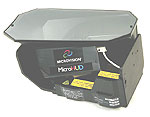
The Microvision MicroHUD projector unit, prior to installation.
In recent years head-up displays, a technology first seen in aeronautics, have begun to appear in automotive design. With instrument readouts displayed on the windscreen a driver need never take his eyes from the road ahead. One such head up display is the MicroHUD from US company Microvision. The MicroHUD, which is being developed for companies including VW, Audi and BMW, projects a virtual image on to the windscreen so that it appears to the driver to be close to the front of the car.
A challenge facing head-up displays in cars is the irregular shape of the windscreen. An asymmetric mirror must be used in the system to project undistorted text or instrument images to the windscreen. Using its own machining control software, Kaleido Technology has been able to produce large high-precision aluminium mirrors with good imaging properties, and average surface roughness of less than 10nm, without the use of any kind of post-polishing. According to Russell Hannigan, director of business development for Microvision, 'The Kaleido mirror in our system is specifically designed for the windscreen of the targeted model car. By simply changing the contour of the mirror we can easily integrate the MicroHUD into a wide range of vehicles'.

